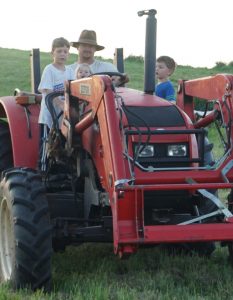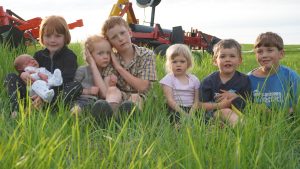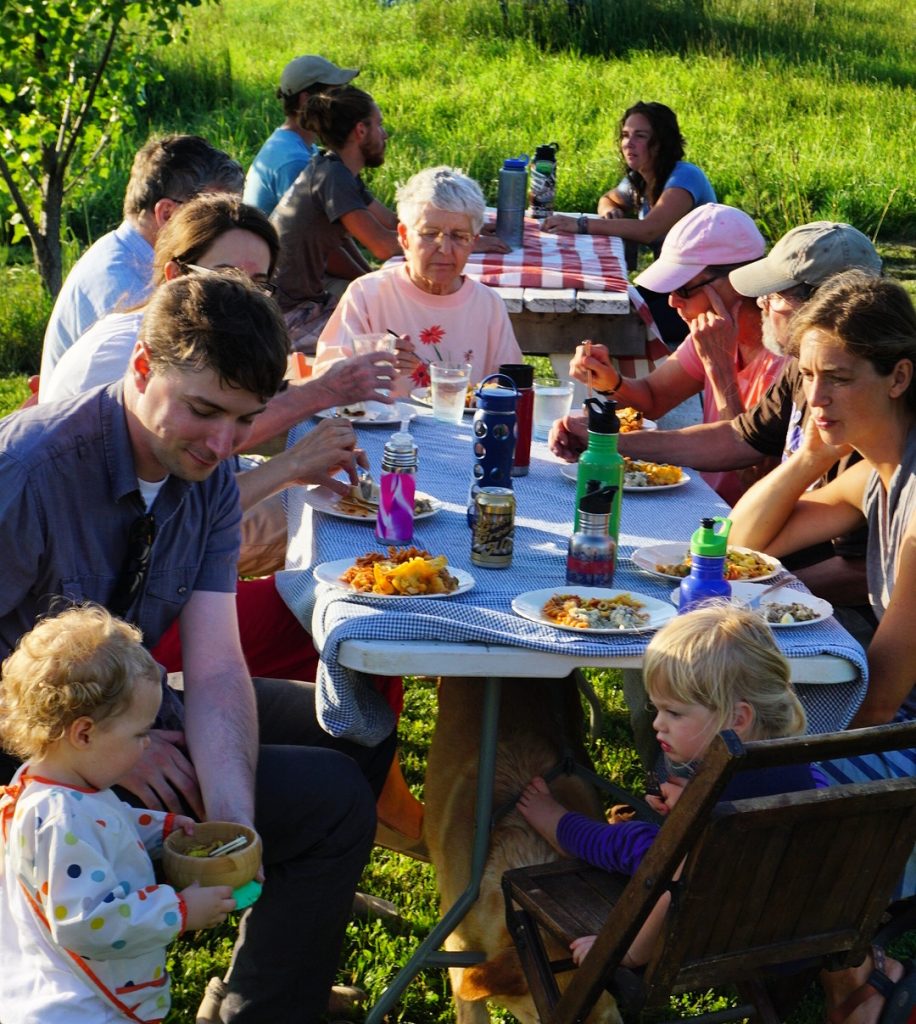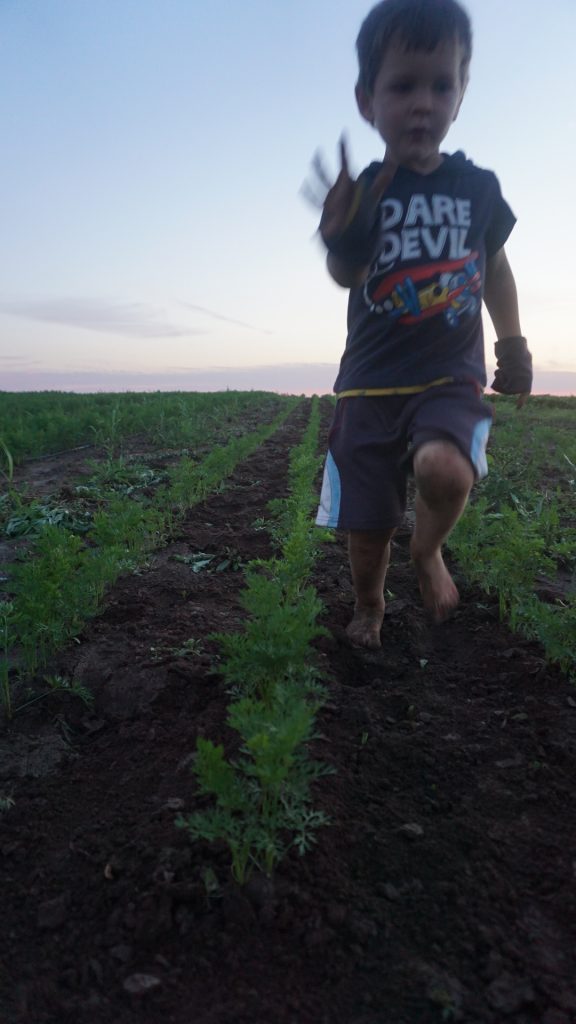Community / Creation / Culture / Faith / Ordinary Life / Spirituality / Work and Rest
Flannery O’Connor: The Patron Saint of Ex-English Major Organic Vegetable Farmers

Seven years ago my wife Hannah and I started an organic vegetable farm in southeastern Minnesota. Like our homesteading ancestors we employed a lot of hard labor and sweat equity to establish our family and farm on what was a bare 30 acres of land. Until we finished building a house last year, we were living on the farm in a 400 square-foot dwelling with three small children and feeling like a slightly more modern version of Little House on the Prairie.
Things are now starting to slow down a bit for us. The intense start-up phase of our farm seems to be passing and we find ourselves with some time to look back and reflect on these whirlwind years. When it got well below zero this winter, I wanted to do some writing on our experience but couldn’t think where to start. Then I got an email from a friend:
“As I see you and Hannah, I don’t believe you are farmers who happen to love Flannery O’Connor in your spare time. That farming is one thing and her writing is something apart for evenings when you can’t be in your fields. You exhibit a wonderful unity, and though I’m not certain how much you have thought about it, I am certain it is worth thinking about. And writing about.”
At first I thought our friends’ assessment of Flannery O’Connor’s significance on our farm was reaching a bit, but then I realized it’s not farfetched. Of all the people that steered us away from the city and into the backwoods of the Deep North, I don’t think anyone played a bigger role than a Catholic fiction writer from the Deep South.

A Late Encounter with Flannery
I was a 21-year-old college student when I first read something by Flannery O’Connor. My friend Sam and I had signed up for a seminar at the University of Minnesota on the mysterious “Southern Gothic” writer from Georgia. We had been told that O’Connor was gaining prominence in the literary world and needed to check her out.
We met at our favorite grungy campus coffee shop called the Purple Onion. With our copies of O’Connor’s Library of America Complete Works, Sam and I settled into a nasty, sticky booth in the smoking section. We had agreed to read the first assigned story, “A Good Man is Hard to Find,” and talk about our first impressions. I remember being pretty skeptical of O’Connor. Her portrait on the cover of the book looked—to my proud, 21-year-old eyes—like an elderly church-lady of 60 or so. Lighting up our roll-your-own cigarettes, we buried our heads in the story.
When I finished and looked up, Sam was waiting for me and said with a big smirky grin, “How did that old grandma write that!”
O’Connor was considered a minor American writer when she died of lupus in 1964 at age 39. Nowadays it would be hard to find an introductory English Literature course where you don’t need to read, “A Good Man is Hard to Find.” Every year, there seems to be more and more writers in publications like The Atlantic and The New Yorker lauding O’Connor’s work and telling how it inspired them. With her ever-growing fame, interpretations of her stories have grown as well and many critics want to claim her as their own.
Luckily, O’Connor wrote a lot about the meaning of her stories. Her collection of essays, Mystery and Manners, and her correspondence, The Habit of Being, are remarkable for their beauty, depth and honesty. They also give us a very clear picture of what O’Connor was consciously doing with her craft.
The Vision of a Backwoods Prophet
O’Connor called herself a “hermit novelist” and said, “My subject in fiction is the action of grace in territory largely held by the devil.” As you read her letters, essays, and the several biographies on her life, you see that from a young age she had a very strong sense of vocation—not only as a fiction writer, but also as a Christian apologist and modern day prophet. Her friend Sally Fitzgerald said that O’Connor came onto the 20th century literary scene, “like having Jeremiah suddenly appear.”
O’Connor, however, didn’t want to be called a “Christian writer.” She thought (from the influence of Jacques Maritain) that a writer’s work should stand on it’s own as art. But she also never shied away from saying that she wrote from the perspective of someone who happened to believe that the world and all of history has an axis mundi and that this central axis is the crucified and risen Jesus Christ.
“Wise Blood,” she wrote of her first novel, “was written by an author congenitally innocent of theory, but one with certain preoccupations. That belief in Christ is to some a matter of life and death has been a stumbling block for readers who would prefer to think it a matter of no great consequence. For them (the protagonist) Hazel Motes’ integrity lies in his trying with such vigor to get rid of the ragged figure who moves from tree to tree in the back of his mind. For the author Hazel’s integrity lies in his not being able to do so. Does one’s integrity ever lie in what he is not able to do? I think that usually it does, for free will does not mean one will, but many wills conflicting in one man. Freedom cannot be conceived simply. It is a mystery and one which a novel, even a comic novel, can only be asked to deepen.”
O’Connor’s prophetic inclinations were fueled by the belief she shared with the philosopher Friedrich Nietzsche that the world operates as if God were dead. She thought this nihilism has progressed to the point that it is now—both in and out of the church—“the gas we breathe.” As a consequence, this lack of faith in the supernatural has dulled the senses to the point that we refuse to see what can’t be proved by science or reason.
To counteract this, O’Connor wanted to impart to her audience a kind of vision that could see beyond the merely material world into the realm where God’s hand is alive and active. To see the divine under-workings in the world, O’Connor said it was necessary to take the time to really look at things—even if it meant gawking. She wrote, “…there’s a certain grain of stupidity that (one) can hardly do without and this is the quality of having to stare, of not getting the point at once. The longer you look at one object, the more of the world you see in it.”
What O’Connor saw looking hard at the world was often not pretty. In her stories as God’s invisible grace collides with very resistant hearts, the visible confrontations are often shocking and violent. She famously defended her use of shock by saying that extreme measures were necessary to reach an audience that refuses to see anything supernatural and operates as if God is dead. “To the hard of hearing you shout,” she said. “and for the almost-blind you draw large and startling figures.”
In “A Good Man,” O’Connor’s writes about a self-absorbed grandmother from Georgia who happens upon an escaped killer who calls himself The Misfit. As the grandmother begs for her life, she has a moment of Grace-filled empathy for him and lovingly reaches out to touch him. As soon as she does, the Misfit recoils and shoots her in the chest. “She would’ve been a good woman,” he drawls, “if it had been somebody there to shoot her every minute of her life.”
The Need for Roots
When I finished my seminar/class on Flannery O’Connor, I thought for sure that I was supposed to be a fiction writer. To this day, it’s hard for me to imagine anyone not wanting to be a writer after reading Mystery and Manners. It became obvious pretty quickly, however, that I was not a fiction writer. I just didn’t have the imaginary gift. So I wouldn’t be one of her protégés. But her writing had a powerful affect on me and it started to change my career path.
I was growing more and more disillusioned with the city. I had grown up in Minneapolis and, after moving away for a while, returned to the city for college. The energy and excitement of the city exhilarated me and I dreamed of living the literary life in New York or Boston. Slowly however, partly from reading O’Connor’s knocks on city life, the country became more appealing. The appeal intensified after I reconnected with some family friends who were organic vegetable farmers. I started having the feeling of being cramped and trapped in the city. The urge was coming over me to find more elbowroom, open spaces, and a closer connection to the land.
After graduating from UMN, I moved to the small town in southeastern Minnesota where I was born and where my family has ancestral roots. I started working for those family friends on their organic vegetable farms. At one of the farms I met my wife Hannah. Not long after we met, 30 acres of prime farmland came up for sale right next to Hannah’s sister’s farm. This land, which we eventually bought, also happened to be just a few miles from where my great-great grandfather had homesteaded 150 years ago.

O’Connor was fascinated by the French writer Simone Weil, whom she called one of two twentieth century women in whom she was most interested. Weil wrote a book called The Need for Roots and argued that the modern world was becoming more disjointed and less humane as it grew more industrialized and urban. This idea comes up a lot in O’Connor’s fiction and essays. As people left the country for the city they became less connected to the land and a particular place. O’Connor feared that urbanization would make it harder for rural communities to maintain their distinctiveness and individuality.
“I think as (the region) gets to be more and more city and less country,” Flannery wrote, “as … everything… is reduced to the same flat level—we’ll be writing about men in gray flannel suits. That’s about all there’ll be to write about, I think, as we lose our individuality.”
Another reason the country became so appealing to me was that it felt so neglected. Everybody I knew wanted to be in the city where all the cool people were. Why would anyone want to move out in the middle of nowhere with the rednecks and hillbillies? But with O’Connor, I found someone making the opposite case. Why would you want to be in the city with the hordes of men in gray flannel suits? Or now, the hipster hordes in skinny jeans and 90s apparel?
When we were dating, Hannah and I talked about things that small-scale farming could bring us that the city couldn’t. The thing that was most appealing was the possibility of making a living as a family and working together on a daily basis. We hoped too, that raising a family on the farm in the country would be a natural way for us to be counter-cultural—in the sense of being in the culture but not of the culture.

We also wanted to be part of building culture, to be part of a small enough community so as to have a real stake, and real responsibility, in that process. We wanted to put down our roots in a particular place, potentially for generations. We wanted to be part of a community where there wasn’t as much pressure to conform to the wider culture, a place with a sense of distinctiveness within a region.
Coming back to Christian realism
We’ve been in the country over seven years now and things haven’t gone exactly according to our vision. Our farm is thriving, but it has been heavy lifting to break into the community. We still haven’t even met many of our immediate neighbors and we know through rumors that, to many, we are just temporary “hippie farmers.” We chose to attend a local church and while we have grown to love the people there and they us, it took years for them to believe that we were really here to stay. It is very odd in our rural area if you are joining a church that you were not born into or in which there is no family connection.
Family life on the farm has brought us many of the blessings we thought it would, but it has also fallen short of our unrealistic expectations. We struggle to balance the never-ending farm work with spending real quality time with our kids. With all the work looming just outside the door, it’s way too easy to let it steal precious time from family and God.
We’ve realized that we will very likely never feel like natives in our area. The roots we put down here are the extremely slow growing kind, like those of a burr oak tree. The hope is that while they are slow growing they are hard-fought and will eventually be the deep and lasting kind.
As our farm mentor, Flannery O’Connor delights in not letting us dwell in warm fuzzy feelings. “There is nothing harder or less sentimental than Christian realism,” she writes. “All human nature vigorously resists grace because grace changes us and the change is painful.” From O’Connor we’ve found that the action of God’s invisible grace hunting down unsuspecting victims is not reserved for the backwoods characters in her stories. This relentless and purifying Grace comes after us again and again.
As Hannah and I move into the post start-up stage of our farm, we hope our community roots begin to flourish as well as our vegetables have. By growing good food—and more good relationships—we want to do our small part to swing the pendulum back away from the city to the country.
I realize it is really hard work, going against the grain, to realize a vision of a life like ours in the country. But with O’Connor I’m worried about the fallout if city life continues to dominate. It’s concerning that without rural places that cultivate deep, distinctive social roots it will be difficult for healthy individuality to flourish. O’Connor also worried that without regional roots our literature would suffer. She argued that having people deeply belonging to their region creates an environment capable of making great art. “The best American fiction has always been regional,” she wrote, “it has passed to and stayed longest wherever there has been a shared past, a sense of alikeness, and the possibility of reading a small history in a universal light.”
I don’t know if the next great American fiction will be written around here, but I think O’Connor helps us see how our place, our life in the country, connects with our Christian faith. “The possibility of reading a small history in a universal light,” is necessary for faith that the one immortal, omnipotent God was born into “a small history”—into a specific time and place and region. We have a need for roots because the Incarnate God had a need for roots. And this Story of all stories forms the basis not only for good fiction, but is the guide for how we are all called to live, work and create in the light of God’s salvation plan.
There is nothing pure or intrinsically better about the country than the city. Deep roots can be established in the city too. The book of Revelation tells us that God has a perfect version of both the city and the country in store for us at the end of the age. We live in the in between of God’s kingdom already bursting forth into the world and the not yet of its final consummation. In the meantime, I hope that the rural, regional distinctiveness makes a bit of a comeback. To have both the city and the country learning things from each other will surely bring a better vision of how divine Grace nourishes God’s plan for his people in the world.

I don’t know a better modern guide for this kind of vision than Flannery O’Connor. With her singular and prophetic voice she can help us see our world in a way that recognizes God’s redemptive power in action. For O’Connor this is no vague spiritual abstraction. It goes back to the very concrete act of staring and gawking that she encouraged. If we look long enough at the things around us we start to see how our “small history” is part of God’s cosmic plan. This kind of concrete, down to earth action, like staring, is what we yokels in the country are supposed to be good at. Because for someone to be able to see successfully, O’Connor writes, it will “be a descent into his region. It will be a descent through the darkness of the familiar into a world where, like the blind man cured in the gospels, he sees men as if they were trees, but walking. This is the beginning of vision.”
Copyright © 2018 Daniel W. Miller


